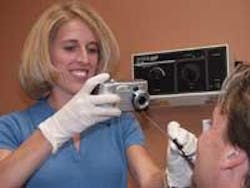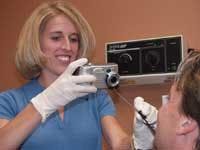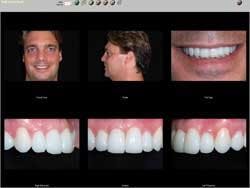Putting your DIGITAL IMAGE assets to work
by Dr. David Gane
When today's dentists plan future technology investments, the list typically includes at least one digital-imaging device, usually a digital camera, digital X-ray system, intraoral camera, or scanner. Digital-imaging devices for dentistry are becoming increasingly popular largely due to the tremendous efficiency and positive return on investment they afford the dental practice. With each successive generation, these devices are increasing in resolution, dropping in price, and becoming easier to implement. Digital cameras are an excellent case in point. Today, dentists can purchase a specialized digital dental camera with excellent color rendition and resolution (3.0 mega pixels is a good fit for most dental applications) at a very reasonable cost.
The latest digital cameras for dentistry also include tools to make digital patient photography easier than ever. The type of camera you should buy depends on who will be taking the images. The Kodak™ DX4900 Dental Digital Camera Kit, for example, has a built-in distance guide and framing tool to facilitate the acquisition of images with proper composition and magnification ratios, virtually taking the guesswork out of standardizing patient photography. The Olympic 2500 kit from PracticeWorks/Dicom is an easy-to-use system that requires a short learning curve. These are great cameras for staff. If the doctor is going to take the images, then you will probably want to look at cameras like the Canon D60.
Digital imaging as a process delivers considerable inherent value. Digital cameras allow dentists or their auxiliary to capture perfect images quickly and efficiently every time. If a particular image isn't acceptable for any reason, it can be retaken immediately before the patient leaves the office. Digital imaging can streamline office procedures, which, in turn, lowers overhead costs.
But perhaps more important is the inherent value of the images themselves. Digital images are essential elements in the diagnosis and treatment-planning process and are fundamental to improving office communications. Digital photos have also proven to be especially useful in increasing patient acceptance of cosmetic treatments when used in conjunction with cosmetic-imaging software. In short, digital images can be readily exploited to improve patient care. Communication is improved with laboratories and in the referral process, as well as administratively in the predetermination of benefits and in assisting third-party insurers in claim adjudication. It is easy to see how a practice's digital images can be a definite economic asset.
This sounds impressive, but it also suggests that simply capturing those images isn't enough. Sitting on a network drive, the images are mere binary files. To realize their full value, you must put them to work. The first step is to review them and select which images you would like to use for which purposes.
Image management
To get the most out of your digital-image assets, you will need to invest in a quality image-management program. Image-management software lets you perform a number of tasks related to the editing and organizing of images. As you choose an image-management package, look for flexibility in the software's functionality. For example, it should be able to organize images by patient name, visit date, and image type. This will ensure that if you need to find and review specific patients' images, you can do so with ease. A desirable image-management software application also should be tightly integrated into your practice-management software, minimizing the administrative overhead associated with tracking files and matching them with their patient records.
Computer display
When you work with digital images, the majority of the time you will be viewing them on-screen. It's important to use a computer monitor that allows you to view images comfortably.
When evaluating computer monitors, the main considerations are CRT or LCD flat-panel display, screen size (measured diagonally), dot pitch, and refresh rate. Dot pitch is an indicator of how sharp a displayed image will be. The lower the dot pitch, the sharper the image. For a dental practice using digital images, computer monitors should have a dot pitch in the range of 0.25 - 0.26 mm.
Another choice to make is whether to purchase a flat-panel LCD (liquid crystal display) monitor or a CRT (cathode ray tube) monitor. LCD screens are a newer technology. In many cases, LCD screens are considered to outperform CRT technology in both color and brightness. If you decide to purchase an LCD screen, look for one with a contrast ratio of 350:1 or better. There is one slight drawback with LCD screens — many don't display gray-scale images as well as color images. If you plan to use your computers to view digitized X-rays, you may want to maintain at least one quality CRT monitor in your practice. Generally speaking, LCDs do a fine job, and for most applications a 15-inch operatory display is adequate. Larger screens are also more expensive, so you'll need to weigh costs against viewing comfort.
Managing and viewing images are necessary steps in putting images to work. Once you decide what images to use, you will generally do one of three things:
1 Print them directly.
2 Import them into another software application.
2 Create digital copies for transmitting via email.
Printing images
Sometimes all a practice needs are some nice hardcopy prints of an image to give to patients, frame for an office display, or mail with an insurance claim or referral. These prints can be generated right from your image-management software. The only other equipment you'll need is a color inkjet printer, and there are no shortages of excellent choices on the market.
For professional-looking images, it is important to use a professional-grade paper. Kodak™ Dental and Medical Imaging Inkjet Paper is a popular choice for dentists because it's designed to produce crisp, glossy digital prints.
Importing into software applications
Another way to use digital images is to incorporate them into documents or computer slideshows. For documents, most practices use a common word processing program, such as Microsoft Word. This task is fairly straightforward, particularly with current versions of Word. To insert a picture, simply copy and paste the desired image into a text box in the Word document. Once the picture is in the document, click on it to activate the pop-up menu that lets you perform the application's simple editing functions. You also can resize the image in the document by selecting and dragging its border icons.
A popular program for creating computer slide shows is Microsoft PowerPoint. The steps for importing an image are very similar to that of Microsoft Word. Once you have the picture on the slide, use the format picture option to size it. This format option also lets you select image resolution. This is an important parameter, because image resolution affects both image quality and file size.
The greater the image's resolution, the more detailed it is. However, higher-resolution images are also bigger files. They take up more room and may load more slowly. So, for PowerPoint slide shows, consider where you'll be displaying the presentation. If it will be shown on a computer monitor that displays at 800 x 600 resolution, there is no reason to use a higher-resolution image. If, on the other hand, you'll be projecting the show (for example, on a Proxima or comparable projector), you'll want to use a higher-resolution copy (probably 1024 x 768) to get clear images with good detail.
Creating digital copies
Many practices also need to create digital copies of images. These copies can then be emailed to insurance providers, referring physicians, or specialists. Or they can be written to compact disk to mail to third parties.
As it is with creating PowerPoint presentations, image resolution is an important consideration. When it comes to emailing images, larger files can be particularly problematic. If you or the recipient use a dial-up Internet connection, the transmission of large image files will be very slow.
Some Internet file servers also limit the amount of space allocated to customers' email accounts. Overly large image files may be blocked if they exceed allowable file space.
As more and more businesses replace slower dial-up email services with faster options, such as DSL or broadband, problems with image file size will become less common. However, it's still a good practice to optimize the resolution of your images according to the needs of the recipient. For example, if the image is intended to be viewed on a computer screen, choose a lower resolution, such as 640 x 480 or less.
At the opposite end of the spectrum are applications that require high resolution. One example is images submitted for publication. In this case, the resolution is typically expressed in terms of printer resolution, which is dots per inch (dpi). Most publications require the images to be printed at 300 dpi. Check with the publication's editor for further specifications.
The future of digital imaging
As dental-product purchasing trends clearly indicate, digital imaging is here to stay and will become increasingly important to the practice of dentistry. Improvements in technology and emerging support services, such as application service providers that offer fee-based image printing and archiving, will further enhance the usefulness of digital images.
To get the most out of digital imaging, though, you must put your images to work. Digital images stored on a computer hard drive are underutilized assets. When you start incorporating them into your daily activities, documents, presentations, and communications, you leverage those assets to their fullest value.
References available upon request.


